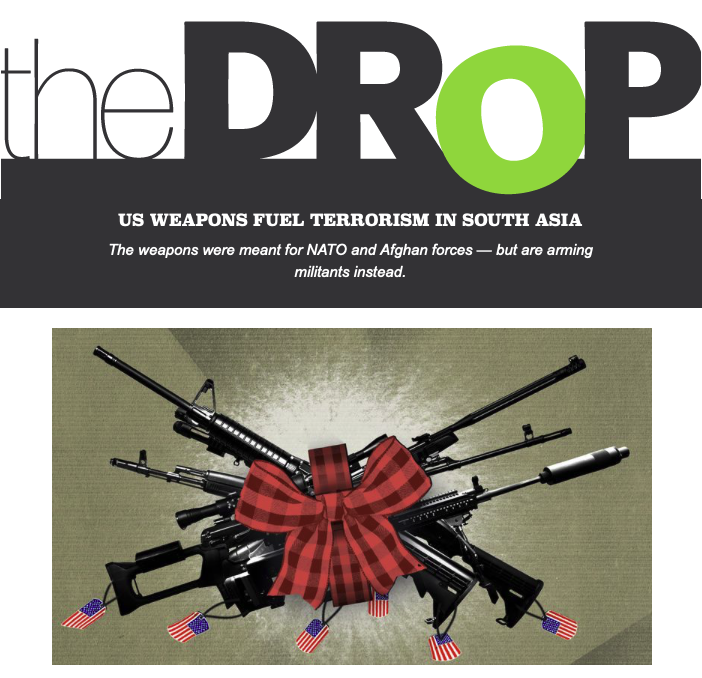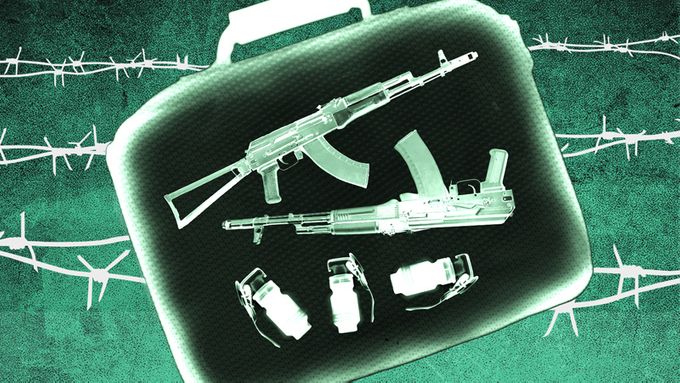US weapons fuel terrorism in South Asia
From The Drop by OZY

From the Taliban (and America), With Love
Weeks before the Tehrik-e-Taliban Pakistan, one of South Asia’s most feared terrorist groups, called an end to its ceasefire with the government of Pakistan in November, it was already showcasing its arsenal in images that made their way to social media.
Experts believe the guns, night vision goggles and other sophisticated gear seen in those photos have been gifted to the Tehrik-e-Taliban Pakistan (TTP) by the group’s ideological brethren, the Afghan Taliban.
But the Taliban hasn’t manufactured or bought cutting-edge military equipment and weapons. Rather, it’s the loot left behind after the U.S. chaotically withdrew from Afghanistan in 2021. Now, almost a year and a half later, those spoils of war are increasingly finding their way to theaters of regional conflict across South Asia, sparking concerns among analysts.
Videos released on social media by insurgent groups from Kashmir have also boasted of M249 automatic rifles, 509 tactical guns, M1911 pistols and M4 carbine rifles — all American-made weapons.



When the Taliban returned to power in Kabul after the collapse of a U.S.-backed government in August 2021, they also took control of a substantial cache of weapons, ammunition, military vehicles and other equipment that NATO forces had ironically hoped to use against the Islamist group.
According to the U.S. Department of Defense, an estimated $7 billion of equipmentpreviously with the Afghan national defense forces was left behind when the Afghan government crumbled and then-President Ashraf Ghani fled the nation by helicopter. Meanwhile, the Taliban claim that they secured more than 300,000 light arms, 26,000 heavy weapons and about 61,000 military vehicles.
The Taliban, who have provided safe haven to the TTP, are now also sharing the weapons left behind by the U.S. An emboldened TTP has launched a wave of deadly attacks across Pakistan, ranging from a Nov. 30 suicide bomb blast in Quetta that claimed four lives and injured dozens of others, to multiple attacks in Balochistan on Dec. 25.
Abandoned U.S. weapons are also making their way to Kashmir, another hot conflict zone. Senior Indian security officials confirmed to this reporter that many of the latest caches of weapons seized from militants in Kashmir can be traced to the U.S. and NATO weapons left behind during the hasty August 2021 withdrawal from Afghanistan.
These weapons include assault rifles with steel-core bullets capable of piercing body armor, night vision goggles and satellite phones. Videos released on social media by insurgent groups from Kashmir have also boasted of M249 automatic rifles, 509 tactical guns, M1911 pistols and M4 carbine rifles — all American-made weapons.
Source of Smuggled Weapons


But not all the weapons spreading across the region from Afghanistan are gifts like the ones the TTP is believed to have received from the Taliban.
Recoveries made from smugglers at the Afghan-Pakistan border have included U.S. arms and ammunition in recent months.
Former Afghan intelligence officials who have continued to track regional smuggling routes confirm that Taliban commanders are trafficking weapons across borders — and like the amorphous nature of the Taliban itself, the smuggling operations aren’t always centrally controlled.
The Taliban have been heavily sanctioned by the U.S. and other countries, and the illicit sale of arms and military equipment is likely a key source of much-needed funding. – Former Afghan intelligence officials



“The Taliban has little control over many of the commanders who maintain influence over these routes,” said one former Afghan official who requested anonymity. “Many of their commanders who were assigned to seize weapons and equipment from former officials, kept it for themselves to be smuggled to groups like Jaish-e-Mohammed [JeM] and Lashkar-e-Taiba [LeT].” The JeM and LeT are Pakistan-based terrorist groups that — unlike the TTP — often work closely with the Pakistani military to support anti-Indian insurgency in Kashmir.
“The Taliban regularly conducts raids and seizes trucks of weapons to show they are cracking down, but in reality their commanders are controlling many smuggling routes,” the former official said. “It is difficult for them to rein them all in, even if they wanted to.”
But the Taliban leadership also has incentives to allow and even encourage the smuggling of these sophisticated weapons, experts pointed out. The Taliban have been heavily sanctioned by the U.S. and other countries, and the illicit sale of arms and military equipment is likely a key source of much-needed funding, they said.
Jonathan Schroden, director at the Virginia-based Center for Naval Analyses, a nonprofit national security research organization, said the factors pushing the Taliban toward the illegal sale of weapons were many. The sheer number of weapons the group inherited, its “need for money to sustain its government in the face of suffocating international sanctions” and its relations with other major regional militant groups create a situation where, “It doesn’t take much to imagine that smuggling of weapons across the region would take place,” he said. “I would personally be shocked if that wasn’t happening.”
In many ways, the flood of weapons at the Taliban’s disposal represents a new turn in Afghanistan’s complex, long-standing and multifaceted problem with internationally sourced arms and ammunition, suggested Justine Fleischner at Conflict Armament Research, an independent investigative organization documenting weapons and ammunition in conflict zones.
“While Afghanistan has been on the receiving end of weapon smuggling for decades, it now stands to become a key source of illicit weapons to criminal and terrorist networks in the region,” Fleischner said.





